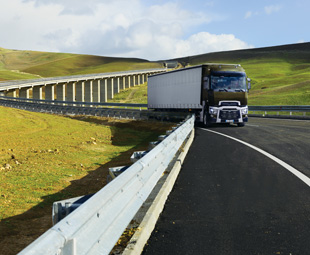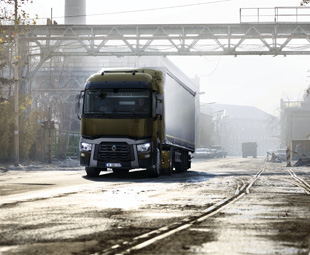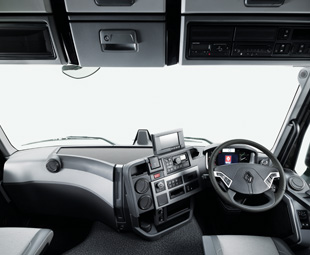Tantalising T

In October, the new Renault K and C ranges will arrive in South African showrooms … To whet our appetites, Will Shiers brings us an exclusive sneak peek at the company’s latest European supermodel – the T range.
“I would like to hear all of the things that are wrong with the T range,” Herve Bertrand, Renault’s chief designer, told the 25 International Truck of the Year jury members at the end of a 280-kilometre drive through Italy. “And I don’t want you to hold back either,” he added bravely.
Bertrand is the man responsible for the truck’s controversial launch colour, so it’s fair to say that he’s no stranger to criticism, but I don’t think he was expecting to see quite so many hands immediately raised into the air. “OK, you first,” he said, pointing to the Romanian jury member …
Day one
Our journey started in Venice the previous morning. The 25 trucks, a mix of 11-litre Sleeper cabs and 13-litre High Sleepers, were lined up along the quayside. They were all finished in silver – the second launch colour and something of an admission that the first choice didn’t do the trucks any favours. It’s amazing the difference a decent colour can make.
Having done a quick walk-around check, which is made easier thanks to a button on the key fob that illuminates all of the truck’s lights, we climbed into our designated truck. With 382 kW (512 hp, but badged 520 hp) and 2 550 Nm of torque, our ride had the most powerful version of the 12,8-litre six-cylinder DTI 13 engine. It was under the flagship High Sleeper cab, which is only available in left-hand drive. This cab has a completely flat floor, whereas the Sleeper version (which is expected to account for 85 percent of European sales) has a 200 mm engine tunnel.
 Inside, the cab is well appointed with plenty of brown leather and quality soft-touch plastics. Both cabs use the same dashboard and we were immediately impressed with its neat, yet functional, design.
Inside, the cab is well appointed with plenty of brown leather and quality soft-touch plastics. Both cabs use the same dashboard and we were immediately impressed with its neat, yet functional, design.
The steering wheel, which is particularly worthy of praise, incorporates multi-function controls for the telephone, cruise control and for navigating the menus. There are more controls on the underside of the steering wheel, which we were only aware of because of the hour-long PowerPoint presentation we had just sat through.
Seeing the numerous controls first hand was something of a relief, as we had struggled to fully understand how everything worked in the classroom session. Now that we were sitting in the driver’s seat and actually playing with the controls, everything made sense. Although there is clearly a lot to get your head around (and a five-hour handover is recommended to get the best from a new T range), scrolling through the various menus is intuitive and even the biggest technophobes should be able to get to grips with it relatively easily.
We started the engine, selected drive on the column-mounted Optidriver transmission control, released the electronic handbrake (which only needs to be released manually at the start of a journey or after a door has been opened), and eased our way out of the parking lot and out of Venice.
The roads were tight, and with so many roundabouts and suicidal moped riders coming at us from all directions, we were glad of the excellent visibility awarded by the rear-view mirrors. Renault has separated the main mirror and the wide-angle mirror, giving the driver a gap to look through.
In control
Once on the motorway, we were able to relax a little and played with the numerous dials and switches. First, we turned on the Optiroll (Renault’s version of Volvo’s EcoRoll), which disengages the driveline where possible to improve fuel economy.
Then we activated cruise control, which was done by rotating a neat dial on the dashboard. It’s curious that it is located here rather than on the steering wheel, but then you only need to turn it on once at the beginning of the journey, so it doesn’t need to be at your fingertips.
Drivers are given a choice of three different Eco Cruise settings (selected via the main menu), which prioritise fuel economy, journey times, or a combination of the two. Each has its own automatic transmission shift strategy, with the third setting changing gear at noticeably higher revs than the other two. The middle setting is a good compromise between fuel economy and performance.
 The Adaptive Cruise Control (ACC) also has three settings: each varying the distance between you and the vehicle ahead. While we had every faith in the system and were impressed by the way in which the Optibrake (engine brake), retarder and service brakes combined to ensure that the distance was maintained, we opted for the setting that left the greatest gap.
The Adaptive Cruise Control (ACC) also has three settings: each varying the distance between you and the vehicle ahead. While we had every faith in the system and were impressed by the way in which the Optibrake (engine brake), retarder and service brakes combined to ensure that the distance was maintained, we opted for the setting that left the greatest gap.
The system worked incredibly well through the hilly section between Bologna and Siena, and wasn’t fooled by the numerous tunnels we encountered. Renault says there are no plans to introduce a GPS-based version of ACC for the time being. “We would sooner wait until the technology is 100 percent,” a spokesman said.
There is nothing revolutionary about anything we have just described, and we have been driving trucks with ACC for about a decade now. The difference is that everything feels right in the Renault. All the controls are at your fingertips and you rarely have to divert your gaze from the road to engage any of the systems. Everything about this truck, is intuitive and simple to use. This is just as well, because we certainly didn’t need any distractions … A combination of spectacular scenery and narrow lanes meant it was taking a lot of concentration not to trigger the lane departure warning system.
Before leaving the autostrade at Siena, we first had to pay a toll. Italian toll booths clearly aren’t designed for high cabs. Compounding the problem is the fact that the T range’s large windows don’t wind all the way down, making it impossible to reach far enough down, meaning you can’t pay from the cab. The only option was to get out of the truck, annoying several impatient Italian motorists waiting behind. In our rush to get away, we forgot that, after the door has been opened, the handbrake has to be manually released. This added another few seconds and several more beeps from behind.
In Siena we were given the choice of spending the night in the Castel Monestaro (arguably Tuscany’s best hotel), or in a High Sleeper. This would be the perfect opportunity for us to wax lyrical about the truck’s extending 800 mm wide bunk, its three ambient lighting modes, the generous storage space, the fact that you can open and close the cab windows from the comfort of your bed and the impressively thick heat-reflective blackout curtains. But we can’t, and you can’t blame us – after all, when it comes to choosing between a flushing toilet in a five-star hotel bathroom and an empty bottle of Pellegrino, there’s no comparison.
Day two
Our transport for the second day, and the 250 km drive to Rome, was a T460 Sleeper. The 10,8-litre DTI-11 is likely to account for 90 percent of sales in the United Kingdom (UK), and 338 kW (453 hp) will undoubtedly be the rating of choice. Maximum torque of 2 200 Nm is available from 950 r/min to 1 400 r/min.
The engine is refined, pleasantly quiet (helped by the common-rail injection) and certainly made light work of our 36 t. During the day we achieved a fuel economy figure of 22 l/100 km, compared with 25 l/100 km the previous day. Although these figures don’t prove anything, we reckon it’s safe to say that the DTI-11 offers a great balance of power and performance.
 The Renault demo driver in the passenger seat knew this engine well, having been part of its development team. He was driving heavily disguised Euro-6 T ranges back in late 2010, and has carried out testing in the Arctic Circle and southern Spain. He admits that, despite being heavily involved in the truck’s development, he never had so much as a glimpse of the cab’s exterior until its official launch in June 2013. “It was as much as a surprise to me as it was to you,” he says.
The Renault demo driver in the passenger seat knew this engine well, having been part of its development team. He was driving heavily disguised Euro-6 T ranges back in late 2010, and has carried out testing in the Arctic Circle and southern Spain. He admits that, despite being heavily involved in the truck’s development, he never had so much as a glimpse of the cab’s exterior until its official launch in June 2013. “It was as much as a surprise to me as it was to you,” he says.
The truck’s looks are certainly distinctive and never failed to turn heads on this trip. A manufacturer needs to have a European vehicle parc of around 5 000 for them to start being a relatively common sight, and Renault expects to hit this figure within the next two months. Until then, the T is going to get plenty of people pointing at it.
Italian autostrades are not great, and we were shocked at just how bad the road was in places. That said, the truck took it in its stride, providing the driver with excellent insulation from the appalling road surface. It proved to be perfectly stable too, and although it isn’t offered with Volvo’s optional dynamic steering, we don’t think it suffers as a result.
As we headed towards the coast, the wind picked up. It didn’t affect the truck’s stability, and the only indication we got was a whistling noise from the mirrors and sun visor. It was the only annoying noise we noticed throughout the trip.
The interior looks smart, and it appears to have been screwed together exceptionally well; there are no squeaks or rattles. That said, there were plenty of French expletives from the passenger seat on the outskirts of Rome when we got horribly lost. It added an hour to our journey and we joined the rest of the group just as Bertrand was asking for the negative feedback.
“The windows don’t wind down far enough,” said the Romanian jury member, and with that most of the other hands went down. A couple of others complained about the location of the dash-mounted cruise control dial and yet another wished that the 10,8-litre engine was available with the flat floor. We add that it’s a pity the UK won’t be getting the High Sleeper in right-hand-drive form, but it’s hardly a deal breaker, as the 200 mm engine tunnel is not obtrusive.
So that’s it. Those are all the obvious faults that 25 international journalists will admit to finding with Renault’s new T range. Bertrand breathes a sigh of relief and we confirm our initial suspicions that this is a very good truck indeed.
As regular readers of FOCUS know, this magazine has been appointed an associate member of the International Truck of the Year (IToY)! FOCUS is the sole South African magazine to have joined this prestigious body. One of the advantages of this association is access to exclusive articles, specially written for FOCUS by ITOY jury members. This is one such article.
Published by
Focus on Transport
focusmagsa




